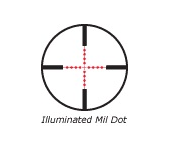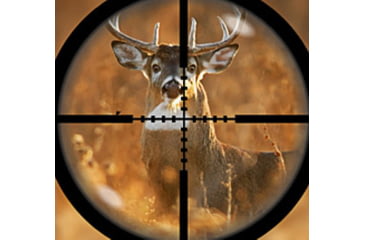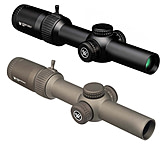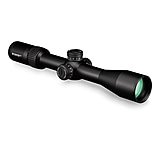What you need to know about reticles is written by one of our Rifle Scope Experts: Steven K. Ledin. In this article he will tell you everything you need to know about reticles.![]()
Focusing Your Reticle
A reticle is the crosshair or aiming point in your field of view in a riflescope. To use a rifle scope reticle properly you must first focus it for your eye. Point your properly mounted rifle scope at the sky or a blank wall with the scope at its highest power. The eyepiece is adjustable on almost all rifle scopes. Some have a locking ring to prevent inadvertent movement. Loosen the locking ring and turn the whole eyepiece in or out a couple of full turns at a time until the scope crosshair is clear and sharp for your eye. Tighten the lock ring. On a fast focus (FF) eyepiece simply turn the ring until the reticle is sharp. On a fast focus eyepiece this may be only a fraction of a turn. Loosen the locking ring first, and tighten afterwards if applicable. Not all fast focus (FF) eyepieces have locking rings.
Basic Reticle
The most basic reticles simply offer an aiming point. Fine crosshairs, Duplex, Nikoplex, 30-30, Heavy Duplex, or whatever the manufacturer wants to call them. They all give you a central aiming point. Thicker reticles show up better in low light or against busy backgrounds like foliage, and help draw your eye towards the center of your field of view. These reticle types are mostly used in hunting rifle scopes where extra precision is not a priority. Fine crosshairs, on the other hand can almost be invisible on a busy background, but excel at allowing you to adjust your shot in minute increments due to the small amount of target your crosshair covers up.
The amount of target your crosshair covers is called subtention. Fine cross hairs have minimum subtention. These are for accurate target guns mostly and easily disappear except on a clean paper target.
There are riflescopes with the reticle located in the first plane or the second plane. Almost all scopes for the American market have the reticle in the second plane. This means that the reticle does not appear larger as the magnification increases, just your target. Again, almost all scopes for the American market are in the second plane. First plane scopes increase the size of the cross hair with the target. Subtention stays the same. On second plane scopes, since the reticle size stays the same as the magnification increases, the subtention decreases. Less of your target is covered by your reticle. First focal plane scopes are offered by manufacturers like Schmidt & Bender, and a few by Leupold, Swarovski, and Barska and others.
Types of Reticles
Bullet Drop Compensating (BDC) Reticles
To understand how these reticles work you must first understand a bit about bullet trajectory. A bullet fired horizontally from a gun will hit the ground at the same time a ball will hit the ground dropped from my hand. Gravity accelerates objects at a constant 32 FPS. What will hit the ground first, a pound of bricks or a pound of feathers? Same. A bullet will hit the ground the same time as this ball, just a couple miles away. If I throw this ball to a person in the parking lot and aim at their chest the ball may land at their feet or bounce before them. I have to aim high to have the ball land at their chest. Same with a bullet. If a target is 100 yards away and my gun barrel is horizontal, the bullet will land low, just like the ball. And just like the ball, I have to aim higher to compensate for gravity's effect on my projectile. How high depends on how fast I throw the ball and how far away my target is. Same with a bullet.
The most popular reticles being offered today by almost all manufacturers have some kind of BDC (bullet drop compensation) reticle in them. On second plane scopes the magnification has to be set at a certain power for these to work, and you need known distances for these to be used correctly. A laser range finder is generally required.
Some very popular rifle scopes with compensating reticles today are the Swarovski BR, the Nikon BDC, the Zeiss Rapid Z, and the Leupold Boone and Crockett and Leupold Varmint Hunter's. Again, most manufacturers will have at least one type of compensating reticle. Keep in mind that second plane American scopes will only work at a certain magnification designated by the manufacturer. Riflescopes in the first plane that increase the size of the reticle along with the target may be used at any power. Some way of range estimation is required for any compensating reticle. Again, use laser range finders. The lines in the reticle excluding the cross hair are called Stadia lines, and are used as aiming points for holdover. Beware, these are not exact. There are too many variables in gun barrels, ammunition, temperature, elevation, humidity, etc. When sighted in for a hunt at 300 yards here, I was about 10 inches off in elevation at around 7000 feet where the air was much thinner and the temperature cooler. You have to actually shoot the gun at specific distances rather than rely on a chart of any kind.
MilDot Reticle
Some reticles such as a mildot reticle can be used to calculate distance. Mil means milradian, not military. A milradian is 1/1000 of a radian. A radian is the angular measurement that is equal to the angle formed at the center of a circle by two radii cutting off an arc whose length is equal to the radius. A mil in a reticle subtends 3.6" at 100 yards. Double that number for 200 yards, triple for 300 yards and so on. A mil is 36" at 1000 yards.

To find the approximate distance to a target using mildot scopes you must first set the magnification at the required power specified by the manufacturer. Then you must know the approximate height of your target. A man may be 6' tall or a torso may be 3' tall. A full mil is from the center of one dot to the center of the next. If your target is covered by 2.5 dots, the size of your target is 2.5 mils. Now here's the tricky part. Multiply the height of the target in yards x 1000 and divide by the height of your target in mils. (2 x 1000=2000 divided by 2.5 mils = 800 yards.) This is the approximate range to your target. You can see that it takes a while to calculate and that it is not the most precise way to measure for distance. It will certainly not tell you how high to aim or adjust, either, but the dots can be used for hold over if you know your trajectory. A mildot reticle is also pretty busy looking, and if you hold over, much of your target may be covered by dots. Military snipers normally deploy teams of two, with one shooter, and one doing the spotting and calculations. Mildots are rarely used anymore, with laser rangefinders being quicker and more accurate. Mildots will never be understood or used as designed by 99% of shooters but it makes them feel like Tactical Timmys. Bottom line, use a laser rangefinder to determine distance.
Illuminated Reticles
Many scopes are offered with lighted reticles. This is so your cross hairs are visible in low light. The problem with this feature on inexpensive rifle-scopes is that even with adjustable lighting controls, the minimum brightness of the reticle is still too bright and immediately destroys any low light capabilities your eyes have developed, and often the reticles are so bright that you can not even see your target. Top-quality scopes have solved this problem through trial and error and minutely adjustable digital controls. Bushnell offers a FireFly reticle which glows after being charged with a flashlight but is not adjustable.








